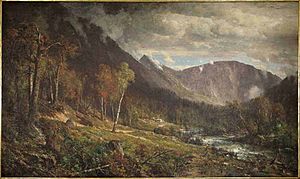Crawford Notch facts for kids
Quick facts for kids Crawford Notch |
|
|---|---|

The Notch of the White Mountains (1839),
by Thomas Cole (1801–1848), looking south past Saco Lake |
|
| Elevation | 1,900 ft (579 m) |
| Traversed by | |
| Location | Carroll / Coos counties, New Hampshire, U.S. |
| Range | White Mountains |
| Coordinates | 44°13′7″N 71°24′42″W / 44.21861°N 71.41167°W |
| Topo map | USGS Crawford Notch, Stairs Mountain, Bartlett |
Crawford Notch is a famous mountain pass in the White Mountains of New Hampshire. A mountain pass is like a natural path or gap through mountains. Most of Crawford Notch is in a town called Hart's Location. About half of this town is part of Crawford Notch State Park, which is a great place to visit.
The highest point of the notch is about 1,900 feet (579 meters) above sea level. This spot is near the town of Carroll. You can find the Crawford Depot train station and Saco Lake here. Saco Lake is where the Saco River begins. This river flows south through the steep sides of the notch. North of the highest point, Crawford Brook flows gently northwest. It eventually joins the Ammonoosuc River, which then flows into the Connecticut River.
U.S. Route 302 goes right through Crawford Notch. This road follows the Saco River southeast towards North Conway. It also follows the Ammonoosuc River northwest towards Littleton.
History of Crawford Notch
The area was first known as White Mountain Notch. European settlers discovered it in 1771, thanks to Timothy Nash. The boundaries of Hart's Grant in 1772 were drawn to fit its unique shape. The notch later got its name from the Crawford family. They were important in the 1800s for building trails and running places for travelers to stay.

In 1803, the Tenth New Hampshire Turnpike was extended through the notch. This road connected Portsmouth to Lancaster. Later, the Portland and Ogdensburg Railroad also built tracks through Crawford Notch. These routes made it easier for settlers to travel through the White Mountains. They could reach Conway and then trading ports on the coast.
A well-known event in the notch happened in August 1826. A large rockslide occurred, which sadly took the lives of the entire Samuel Willey family. They had left their home for a prepared shelter during a storm. However, they were buried by the slide. Their home, surprisingly, was not damaged. Mount Willey, on the west side of the notch, is named in their memory. This event also partly inspired a short story by Nathaniel Hawthorne called The Ambitious Guest. Further down the notch, Nancy Brook and Mount Nancy are named after an earlier sad event.
In the Carroll part of the notch, the Appalachian Mountain Club has a special place. It's called the Highland Center Lodge and Conference Center. This center is on the site of the old Crawford House Hotel, which burned down in 1972. The club has also fixed up the old train depot. This depot is a beautiful Victorian-era building. It now has a bookstore. The depot is still a stop for the scenic "Notch Train" of the Conway Scenic Railroad. This train runs during certain seasons from North Conway.
Things to See in Crawford Notch
- Grave of Samuel Bemis: He was one of the first people to photograph the American landscape.
- Mount Willard: This mountain has an open top near the center of the notch. From here, you can see amazing views of the notch's structure.
Images for kids


